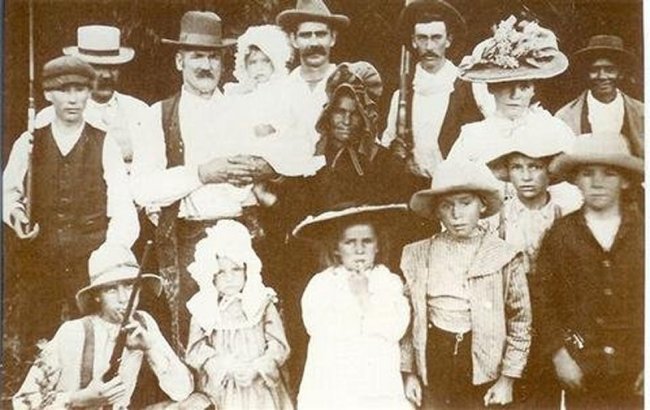Black Founders: The Unknown Story of Australia's First Black Settlers.
NEXT TIME YOU HEAR of Ned Kelly and his gang, spare a thought for a man called Caesar, whose much earlier career of banditry differs from the standard outlaw narrative in one intriguing aspect. As Cassandra Pybus bluntly explains: "Australia's first bushranger was black as pitch."
Why, during the last decade of the 18th century, was an African-American toting a gun in the bush outside Sydney Cove? To answer, Pybus takes us to the Virginia of the American Revolution, where insurgent colonists demanding death or liberty unwittingly inspired the same sentiment in their slaves. To derail the revolutionary movement, Lord Dunmore, the British governor, opportunistically offered freedom to "all indented servants, Negroes or others that are able and willing to bear arms".
Hundreds of blacks duly flocked to fight against their American masters in Dunmore's newly created "Ethiopian regiment".
"There is not a man of them but would leave us if they believed they could make their escape," lamented one of George Washington's relatives about his slaves. "Liberty is sweet."
Perhaps so, but the fate of most of the Virginia runaways proved bitter. Smallpox decimated the black regiment, and Britain's ultimate defeat left thousands of escaped slaves to the mercy of their former owners, given to punishing escapees with mutilation and execution. As the British fleet evacuated, freed blacks desperately scrambled for a place on the last ships out of New York.
Those who obtained a berth (and were thus recorded in The Book of Negroes, one of Pybus' key sources) discovered a new world of problems in London. Without marketable skills and living in fear of man-stealing gangs, many sank into destitution. Inevitably, some black refugees fell foul of the law - and more than a few were transported to Botany Bay (Sydney).
There they encountered a brutality not so different from that in Virginia. For instance, the British authorities gave the contract to transport the Second Fleet to a firm of slavers who packed the hulks so tightly that a quarter of convicts perished before the ships arrived in 1790. "The slave trade is merciful," said one officer, "compared with what I have seen in this fleet."
That year, the colonial rulers increased the punishment for starving convicts who stole food to an extraordinary 2000 lashes: by contrast, the Royal Navy, scarcely known for its humanitarianism, limited flagellators to a few hundred strokes at a time.
The ostensibly free settlers fared little better. The marines on the First Fleet sought refuge from disease and hunger in alcoholic obliteration, flatly refusing to sail without a guaranteed supply of liquor: rum, they explained, constituted "an indispensable requisite for the preservation of our lives".
Incredibly, some of the black Americans thrust into almost impossible conditions on a strange continent managed to flourish. Billy Blue, transported in 1801 for stealing sugar, cemented a relationship with Governor Macquarie based upon their shared experiences in the Revolutionary War.
He ran a ferry service (and smuggling racket), lent his name to Blues Point and other landmarks, and became such a well-known (albeit disreputable) character of early Sydney that some 20th-century historians tried, rather preposterously, to claim him as white - or, at least, "not predominantly Negro".
Other ex-slaves refused to buckle under. Pybus tentatively identifies the bushranger Caesar with a 14-year-old Creole slave boy listed in the Book of Negroes of 1783 as a "stout fellow"; he was transported for stealing three years later.
His name reflected the tendency of slavers to give their chattels mock-heroic titles (rather as a pet-owner might bestow the regal "Rex" on a dog) but, by escaping so repeatedly into the bush, Caesar - almost two metres tall and immensely strong - achieved a degree of recognition on his own terms.
He told Governor Hunter that "he would neither come in or suffer himself to be taken alive"; another convict, spurred by the official promise of five gallons of spirits for "whoever shall secure this man Black Caesar", shot him dead in 1796.
Working from the most fragmentary sources, Pybus reconstructs some of the lost lives of the black diaspora, transforming one-line entries in convict ledgers into whole personalities - from the former slave John Moseley, who ended his life as a dealer living in the Rocks in Sydney, to John Randall, a drummer in the Revolutionary War, whose great grandson was shot as a lunatic in the Snowy Mountains in 1906, muttering about a worldwide conspiracy to murder all black people.
Black Founders provides very different views of the birth of a nation. As Pybus explains, "the settlement of Australia was a multiracial process that took place at a time when the notion of 'race' was a highly malleable construct, understood in ways very different from the modern sense of innate nature".
Yes, white Australia has a black history - and it's more complicated and fascinating than most of us ever knew.
https://www.theage.com.au/entertain...ias-first-black-settlers-20060617-ge2jae.html

